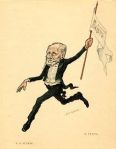Ballet divertissement in one act
Music by Riccardo Drigo
World Première
29th May [O.S. 17th May] 1896
Imperial Bolshoi Theatre, Moscow
Original 1896 Cast
The White Pearl
Pierina Legnani
The Genie of the Earth
Pavel Gerdt
The King of the Corals
Nikolai Aistov
The Pink Pearls
Adelaide Giuri
Lyubov Roslavleva
The Black Pearls
Anna Johansson
Claudia Kulichevskaya
The Yellow Pearl
Matilda Kschessinskaya
Her Cavalier
Nikolai Legat
Saint Petersburg Première
15th February [O.S. 3rd February] 1898
Imperial Mariinsky Theatre
Plot
The Pearl is set in a colossal subterranean grotto where the White Pearl, the most precious pearl on Earth, resides with her sister pearls of differing colours. The Genie of the Earth descends to the ocean floor in an attempt to abduct the White Pearl as an adornment for his crown. The King of the Corals comes to the White Pearl’s aid by causing a battle between the elements of the earth and of the sea. The Genie of the Earth succeeds in capturing the White Pearl and the King of the Corals, thereupon, orders all of the ocean denizens to salute the Genie of the Earth side by side with the White Pearl. In an apotheosis, the Triumph of Amphitrite and Poseidon is depicted.

History
The Pearl was created by Petipaand Riccardo Drigo as a lavish piece d’occasion for the gala given at the Imperial Bolshoi Theatre of Moscow in celebration of the coronation of Tsar Nicholas II and Tsarina Alexandra Fyodorovna. Petipa’s libretto for the new ballet was based on the scenario of the danced tableau La Pérégrina: Ballet de la Reine from Giuseppe Verdi’s opera Don Carlos, which was never performed and was to have been choreographed by Petipa’s brother Lucien. The cast for the première of The Pearl at the coronation gala featured the highest ranking dancers of both the Imperial Ballet of Saint Petersburg and of the Ballet of the Imperial Bolshoi Theatre of Moscow.

While the ballet was in the early stages of production, a list of potential dancers for inclusion in the cast was drawn up for review by a committee responsible for the coronation and its subsequent celebrations. Among those chosen for consideration in the principal roles was the Tsar’s former mistress, Matilda Kschessinskaya. In light of the history between Kschessinskaya and the new Tsar, his mother the Dowager Empress Maria Feodorovna demanded that the ballerina be removed from the cast, as it would have been considered scandalous for the Tsar’s former mistress to perform in front of his wife. However, when the scheming Kschessinskaya learned of this, she was outraged and successfully appealed to the Tsar’s uncle, the Grand Duke Vladimir Alexandrovich to have her reinstated into the cast, despite the fact that at this point, Petipa and Drigo had completed all of the choreography and music. Petipa became extremely frustrated when he learned that he and Drigo were nonetheless required to compose a new number for Kschessinskaya, which took the form of a classical pas de deux for a new role, “the Yellow Pearl” and her cavalier, who was danced by Nikolai Legat.

The Pearl was first presented after a performance of scenes from Mikhail Glinka’s opera A Life for the Tsar on the 29th May [O.S. 17th May] 1896. The ballet was later transferred to the regular repertoire of the Imperial Ballet, where it was first performed on the 15th February [O.S. 3rd February] 1898 at the Imperial Mariinsky Theatre. Petipa would revive the ballet on only one occasion for a gala performance given at Peterhof Palace in 1900. The Pearl was performed often throughout the early 1900s and was given its final performance in 1910, after which, it fell into obscurity. Only one variation from The Pearl was notated in the Stepanov notation method and this variation is part of the Sergeyev Collection.
The only number from Drigo’s score that is used today is a pizzicato variation, which is used by Yuri Burlaka in his Rose Pas de quatre as the variation for the goddess, Aurora.

Related pages
Libretto
Sources
- Petipa, Marius, The Diaries of Marius Petipa. Translated ed. and introduction by Lynn Garafola. Published in Studies in Dance History 3.1. (Spring 1992)
- Petipa, Marius (1971) Мариус Петипа. Материалы. Воспоминания. Статьи. Marius Petipa. Materials, Recollections, Articles. Leningrad: Iskusstvo (Искусство) A. Art
- Jürgensen, Knud Arne (1995) The Verdi Ballets. Istituto nazionale di studi verdiani
- Kschessinskaya, Matilda, H.S.H. The Princess Romanovsky-Krassinsky (1960) Dancing in Petersburg: The Memoirs of Mathilde Kschessinskaya. Alton, Hampshire: Dance Books Ltd
- Pleshcheyev, Alexander Alexeyevich (1899) Наш балет, 1673-1899 (Our Ballet), 2nd supplemented ed. with forward by K.A. Skalkovsky, Th. A. Pereyaslavtsev and A.A. Pleshcheyev
- Travaglia, Silvio (1929) Riccardo Drigo, l’uomo e l’artista. Guglielmo Zanibon
- Levenson, A.A. (1896) Imperial Coronation Program for the Gala Presentation at the Imperial Bolshoi Theater in Moscow 17 May 1896 on the occasion of the Holy Coronation of His Imperial Majesty the Sovereign Emperor Nikolai Aleksandrovich and Her Imperial Majesty the Sovereign Empress Aleksandra Feodorovna.
Photos and images: © Dansmuseet, Stockholm © Большой театр России © Victoria and Albert Museum, London © Государственный академический Мариинский театр © CNCS/Pascal François © Bibliothèque nationale de France © Musée l’Opéra © Colette Masson/Roger-Viollet © АРБ имени А. Я. Вагановой © Михаил Логвинов © Михайловский театр, фотограф Стас Левшин. Партнёры проекта: СПбГБУК «Санкт-Петербургская государственная Театральная библиотека». ФГБОУВО «Академия русского балета имени А. Я. Вагановой» СПбГБУК «Михайловский театр». Михаил Логвинов, фотограф. Martine Kahane.
